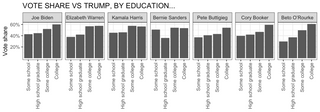A crowded Democratic field, and a close presidential election
US President Donald Trump faces re-election in a little over a year in November 2020. Both the Democratic and Republican parties are preparing for their primary elections. These are within-party elections that decide each party’s candidate for the presidency, and other elected offices. Although Donald Trump is unlikely to face a serious contest for the Republican nomination, the Democratic Party has a crowded field.
In late July, the United States Studies Centre and YouGov polled 1,800 Americans and 1,820 Australians. This was done to find out who Democrats and Republicans wanted to represent their party in the 2020 US presidential election, and who Americans would vote for if the election were held now. These surveys also assessed Australian preferences on which party should supply the next president of the United States.
Dr Shaun Ratcliff, a lecturer in political science at the United States Studies Centre, said the USSC-YouGov poll in the US shows that 2020 could be a close contest. On the other hand, Australians strongly support a Democratic win.
“Depending on who the Democratic candidate is, it is easy to foresee a second term of the Trump administration”, he said.
“Trump is heavily supported as the preferred Republican candidate, among men, women, younger and older Republican Party identifiers. Biden is leading among Democrats, but with significant competition. Historically, he has been a weak candidate in presidential primaries, so things could change. At this stage, though, it is easy to imagine a Biden/Trump presidential contest.”
Looking at vote intentions for the November 2020 general election, Dr Ratcliff said that Trump was behind the three leading Democrats, but only by a few points, and was tied or beating the other serious Democratic candidates at this early stage.
“A Trump win is a real possibility,” he said.
“As of late July, only Kamala Harris, Elizabeth Warren and Joe Biden were leading Donald Trump, all in the neighbourhood of 44 or 46 per cent to 41 to 43 per cent. These results are broadly similar to the popular vote at the 2016 election.
"All other candidates, including Bernie Sanders, are either tied with or lose to President Trump, in our data.
“For many of these other candidates it is easy to imagine that their current disadvantage against Donald Trump is lower name recognition. Most of them have not been significant figures on the national stage for very long. This rationale does not apply to Bernie Sanders, though, who had a large national platform for much of 2015 and 2016 and still loses to Trump according to our data.
“Of course, this is a year out from the campaign proper, and many things could happen between now and then. However, it does indicate that this will probably be another close election.”
United States Studies Centre CEO, Professor Simon Jackman, said that further analysis reveals important differences in the demographic composition of support for the Democratic candidates.
“More competitive candidates — Harris, Warren, Biden — obtain higher levels of support among Black and Hispanic voters, younger voters, and women. Less competitive candidates such as Buttigieg, Booker and O’Rourke tend to not do as well with these groups. They also lose out with less well-educated voters.
“The outlier here is Bernie Sanders, though. Sanders polls well with younger voters, but his support drops steeply with those aged 45 and older. He loses some support among the college educated, but does quite well with voters who have not finished high school. Like other apparently less competitive Democratic candidates, Sanders also loses support from African-American and Hispanic voters.”
Professor Jackman said that while some Democrats poll more strongly than others, falls in support for Democratic candidates do not translate into gains in support for Donald Trump.
“Rather than expressing a preference for Trump, some respondents report that they would not vote or would support a third party or independent if their preferred Democratic candidate was not on the ballot. The fact that this set of voters are not switching from supporting Democratic candidates to supporting Trump suggests that there is an opportunity for the Democratic nominee to pull these voters back into the Democratic column in November 2020."
But don't forget the Electoral College
Professor Jackman said that recent US political history vividly reminds us that the American presidency is not decided by national vote tallies (the so-called “popular vote”). Rather, presidential elections are decided by a majority of the Electoral College, a system of indirect election where the winner of the presidential election in each state (except Maine and Nebraska) wins all of the Electoral College seats for that state, which are allocated across states in a way that is roughly proportional to population.
“Like George W. Bush in 2000, Donald Trump won the presidency in 2016 despite winning fewer votes nationwide than the Democratic candidate,” Professor Jackman said.
“Indeed, Trump won the presidency despite trailing Clinton by 2.1 per cent nationally, 45.9 per cent to 48 per cent, winning the Electoral College with narrow wins in 'Obama' states such as Michigan, Wisconsin and Pennsylvania. Clinton, on the other hand, won lopsided victories in large, blue states, including California, New York and Illinois.
“Accordingly, national polls showing Democrats leading Trump need to be interpreted cautiously. It is entirely plausible that the geographic distribution of 2020 support for Trump will closely track its 2016 distribution, with the distinct possibility of Trump again winning the presidency despite not being the plurality vote winner. Democrats with two, three or even five-point leads over Trump in national polls — especially this far out from the 2020 election — can hardly be confident of winning.
“As the 2020 election nears, the US Studies Centre will be increasingly focused on polling in a small number of pivotal battleground states.”
Australians prefer a Democratic president
Dr Ratcliff said that Australians are not so evenly divided on the presidential contest, preferring that a Democrat win in 2020, regardless of who the candidate is.
“By a ratio of two to one, Australian respondents preferred an unnamed Democrat defeat Donald Trump in November 2020 and become the next US president. Young or old, Labor or Coalition, a Democratic win always appears to be the preferred option for most Australians,” Dr Ratcliff said.
“Only 19 per cent of Australians want to see a second term of the Trump administration. Even among Coalition voters this number is low, with less than one third saying his re-election is their preferred outcome. Support for a Democratic president, which ranges from 41 per cent among all Australians, and 53 per cent and 57 per cent among Labor and Greens voters, respectively, suggests that Australia’s aversion to the Trump administration has as much (or more) to do with the president than it does the political colours he wears.
“Men and women in Australia are equally supportive of a Democratic win (41 per cent each). Men are twice as likely than women to prefer a Trump win over any other 2020 outcome, 26 per cent to 13 per cent. Across age groups, there is little variation in opinion, with 43 per cent of those aged 18-29 preferring a Democratic win, the same percentage as those aged 65 and older. Just 14 per cent of the younger group prefer a Trump win compared with the 24 per cent of the older group.
“Why do only just over half of Australia’s left-wing voters want a victory for the left-wing party in the United States? The figures for both Donald Trump and the Democratic candidate are driven lower in the Australian sample by the large number of voters who say they would prefer another candidate, or who are not sure (both options chosen by 20 per cent of Australian respondents). This may reflect uncertainty about American politics, unhappiness with the Republican candidate, or unwillingness to support an unnamed Democratic candidate.”
About these surveys
Surveys were fielded on the YouGov online panel in both countries between 23-29 July 2019. Responses were weighted by YouGov to ensure samples representative of the Australian and American populations. The Australian sample was weighted by age, gender and location. The US sample was weighted by age, gender, race, education, and vote choice at the 2016 presidential election. The margin of error is approximately ± 2.5 percentage points for results reported for the full sample of both the Australian and American surveys. It is larger for sub-groups of the full samples.
Headline results
Republican primary vote
If the Republican Primary or Caucus for President were held today, for whom would you vote or lean toward? Please select one option only. (Asked only of respondents reporting that they are registered to vote and identifying as Republicans.)
|
Candidate |
Vote share (%) |
|
Donald Trump |
86 |
|
Bill Weld |
3 |
|
Other |
1 |
|
Undecided |
10 |
|
Will note vote |
1 |
Democratic primary vote
If the Democratic Primary or Caucus for President were held today, for whom would you vote or lean toward? Please select one option only. (Asked only of respondents reporting that they are registered to vote and identifying as Democrats.)
|
Candidate |
Vote share (%) |
|
Joe Biden |
29 |
|
Elizabeth Warren |
18 |
|
Kamala Harris |
14 |
|
Bernie Sanders |
11 |
|
Pete Buttigieg |
7 |
|
Cory Booker |
3 |
|
Beto O’Rourke |
3 |
|
Other |
2 |
|
Undecided |
13 |
|
Will note vote |
1 |
Presidential vote intention
If the election for president were being held today, and the candidates were the Democrat and Donald Trump the Republican, for whom would you vote? Please select one option only.
Presidential vote, Donald Trump vs…
|
The Democratic candidate |
Democratic vote share (%) |
Republican vote share (%) |
Other candidate vote (%) |
Will not vote (%) |
|
Kamala Harris |
46 |
41 |
8 |
5 |
|
Elizabeth Warren |
45 |
43 |
7 |
5 |
|
Joe Biden |
44 |
41 |
8 |
6 |
|
Bernie Sanders |
42 |
44 |
11 |
4 |
|
Cory Booker |
41 |
43 |
10 |
7 |
|
Beto O’Rourke |
39 |
42 |
13 |
6 |
|
Pete Buttigieg |
36 |
42 |
14 |
8 |
Who would Australians prefer to see win?
In 2020 there will be a presidential election in the United States. Regardless of who the Democratic candidate is, if the Republican candidate is President Donald Trump, who would you rather won the election? Please select one option.
Who Australians want to win 2020 US election
|
Candidate |
Proportion preferring (%) |
|
The Republican candidate, Donald Trump |
19 |
|
The Democratic candidate |
41 |
|
Another candidate |
19 |
|
Not sure |
21 |
Detailed results
The Democratic primary
If the Democratic Primary or Caucus for President were held today, for whom would you vote or lean toward? Please select one option only. (Asked only of respondents reporting that they are registered to vote and identifying as Democrats.)
By race
|
Candidate |
White (%) |
Black (%) |
Hispanic (%) |
Other (%) |
|
Joe Biden |
22 |
45 |
35 |
23 |
|
Elizabeth Warren |
24 |
3 |
14 |
23 |
|
Kamala Harris |
13 |
13 |
20 |
12 |
|
Bernie Sanders |
11 |
8 |
14 |
14 |
|
Pete Buttigieg |
10 |
1 |
4 |
0 |
|
Cory Booker |
2 |
8 |
0 |
0 |
|
Beto O'Rourke |
2 |
3 |
4 |
6 |
|
Other |
3 |
0 |
0 |
5 |
|
Undecided |
12 |
15 |
8 |
15 |
|
Will not vote |
1 |
1 |
1 |
0 |
By gender
|
Candidate |
Male (%) |
Female (%) |
|
Joe Biden |
29 |
29 |
|
Elizabeth Warren |
18 |
18 |
|
Kamala Harris |
15 |
13 |
|
Bernie Sanders |
12 |
10 |
|
Pete Buttigieg |
9 |
5 |
|
Cory Booker |
3 |
3 |
|
Beto O'Rourke |
2 |
3 |
|
Other |
3 |
2 |
|
Undecided |
8 |
16 |
|
Will not vote |
1 |
1 |
By age
|
Candidate |
Aged 18-29 |
Aged 30-44 |
Aged 45-64 |
Aged 65 and older |
|
Joe Biden |
20 |
21 |
37 |
34 |
|
Elizabeth Warren |
23 |
14 |
19 |
17 |
|
Kamala Harris |
8 |
11 |
16 |
20 |
|
Bernie Sanders |
15 |
22 |
5 |
4 |
|
Pete Buttigieg |
9 |
8 |
4 |
8 |
|
Cory Booker |
6 |
1 |
4 |
0 |
|
Beto O'Rourke |
3 |
5 |
2 |
1 |
|
Other |
5 |
0 |
2 |
3 |
|
Undecided |
11 |
5 |
11 |
13 |
|
Will not vote |
0 |
2 |
0 |
1 |
By education
|
Candidate |
Some school |
High school |
Some college |
College |
|
Joe Biden |
31 |
38 |
31 |
20 |
|
Elizabeth Warren |
8 |
14 |
18 |
23 |
|
Kamala Harris |
18 |
9 |
15 |
16 |
|
Bernie Sanders |
22 |
8 |
11 |
11 |
|
Pete Buttigieg |
2 |
5 |
6 |
10 |
|
Cory Booker |
4 |
2 |
3 |
3 |
|
Beto O'Rourke |
5 |
3 |
1 |
3 |
|
Other |
0 |
4 |
1 |
2 |
|
Undecided |
9 |
16 |
13 |
10 |
|
Will not vote |
0 |
1 |
1 |
1 |
The Republican primary
If the Republican Primary or Caucus for President were held today, for whom would you vote or lean toward? Please select one option only. (Asked only of respondents reporting that they are registered to vote and identifying as Republicans.)
By race
|
Candidate |
White (%) |
Black (%) |
Hispanic (%) |
Other (%) |
|
Donald Trump |
87 |
100 |
81 |
78 |
|
Bill Weld |
2 |
0 |
10 |
3 |
|
Other |
1 |
0 |
0 |
0 |
|
Undecided |
9 |
0 |
9 |
19 |
|
Will not vote |
1 |
0 |
0 |
0 |
By gender
|
Candidate |
Male (%) |
Female (%) |
|
Donald Trump |
89 |
82 |
|
Bill Weld |
3 |
2 |
|
Other |
0 |
1 |
|
Undecided |
6 |
14 |
|
Will not vote |
1 |
1 |
By age
|
Candidate |
Aged 18-29 |
Aged 30-44 |
Aged 45-64 |
Aged 65 and older |
|
Donald Trump |
59 |
75 |
93 |
95 |
|
Bill Weld |
9 |
5 |
1 |
0 |
|
Other |
5 |
1 |
0 |
1 |
|
Undecided |
28 |
16 |
6 |
5 |
|
Will not vote |
0 |
4 |
0 |
0 |
By education
|
Candidate |
Some school |
High school |
Some college |
College |
|
Donald Trump |
92 |
89 |
84 |
84 |
|
Bill Weld |
3 |
3 |
3 |
1 |
|
Other |
0 |
0 |
3 |
0 |
|
Undecided |
6 |
8 |
10 |
12 |
|
Will not vote |
0 |
0 |
1 |
2 |
Presidential vote intention, by selected demographics




Who Australians prefer to see win, by selected demographics and party identification
By party identification
|
Candidate |
Labor |
Coalition |
Greens |
Other |
|
The Republican candidate, Donald Trump |
11 |
29 |
5 |
31 |
|
The Democratic candidate |
53 |
33 |
57 |
15 |
|
Another candidate |
18 |
17 |
22 |
19 |
|
Not sure |
17 |
21 |
16 |
35 |
By gender
|
Candidate |
Male (%) |
Female (%) |
|
The Republican candidate, Donald Trump |
26 |
13 |
|
The Democratic candidate |
41 |
41 |
|
Another candidate |
17 |
20 |
|
Not sure |
16 |
26 |
By age
|
Candidate |
Aged 18-29 |
Aged 30-44 |
Aged 45-64 |
Aged 65 and older |
|
The Republican candidate, |
14 |
19 |
20 |
24 |
|
The Democratic candidate |
43 |
42 |
37 |
43 |
|
Another candidate |
20 |
15 |
21 |
19 |
|
Not sure |
23 |
24 |
22 |
15 |
By education
|
Candidate |
Less than year 12 (%) |
Year 12 or equivalent (%) |
Advanced Diploma |
University |
|
The Republican candidate, |
22 |
21 |
20 |
17 |
|
The Democratic candidate |
29 |
35 |
35 |
51 |
|
Another candidate |
21 |
21 |
21 |
16 |
|
Not sure |
28 |
24 |
24 |
16 |








